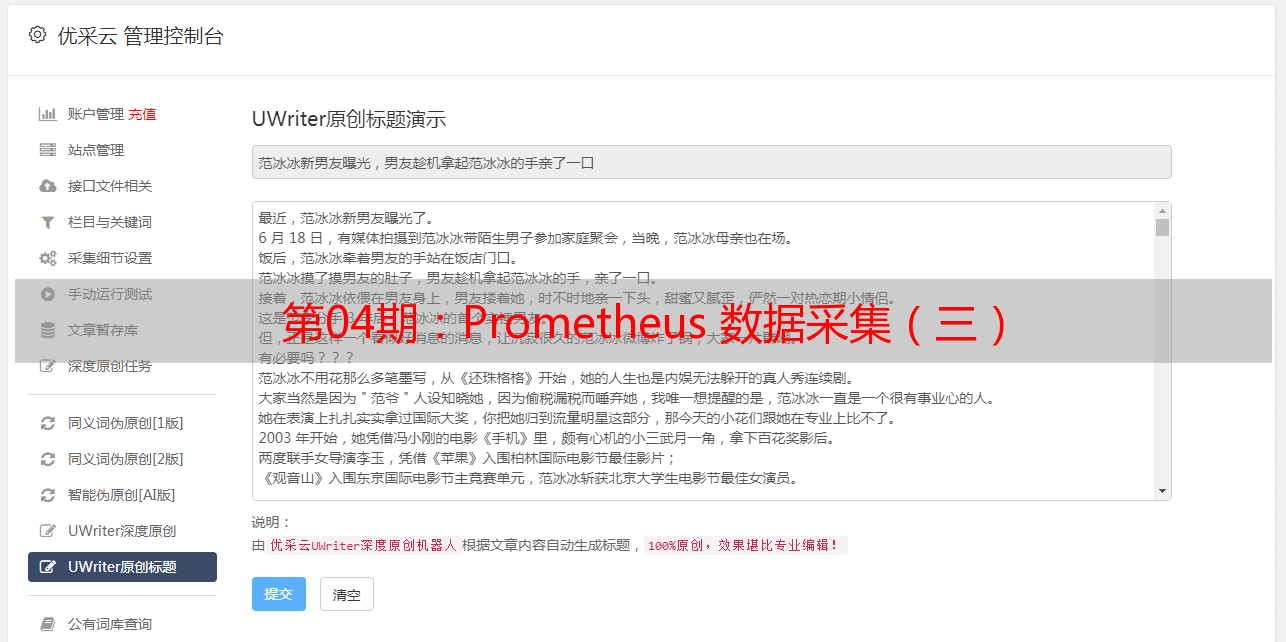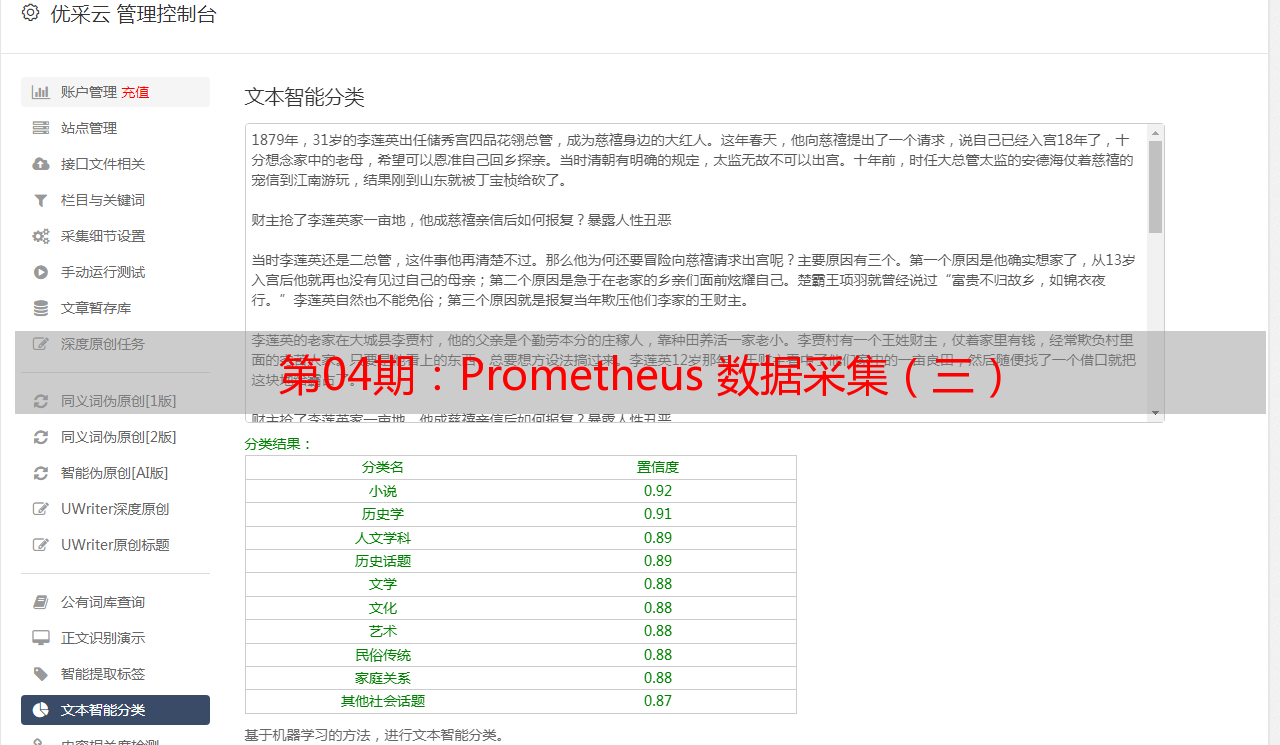第04期:Prometheus 数据采集(三)
优采云 发布时间: 2020-08-17 22:27第04期:Prometheus 数据采集(三)
本期作者:罗韦
爱可生上海研发中心成员,研发工程师,主要负责 DMP 平台监控告警功能的相关工作。
Prometheus 的监控对象各式各样,没有统一标准。为了解决这个问题,Prometheus 制定了一套监控规范,符合这个规范的样本数据可以被 Prometheus 采集并解析样本数据。Exporter 在 Prometheus 监控系统中是一个采集监控数据并通过 Prometheus 监控规范对外提供数据的组件,针对不同的监控对象可以实现不同的 Exporter,这样就解决了监控对象标准不一的问题。从广义上说,所有可以向 Prometheus 提供监控样本数据的程序都可以称为 Exporter,Exporter 的实例也就是我们上期所说的"target"。
Exporter 的运行方法Exporter 有两种运行方法Exporter 接口数据规范
Exporter 通过 HTTP 接口以文本方式向 Prometheus 暴露样本数据,格式简单,没有嵌套,可读性强。每个监控指标对应的数据文本格式如下:
# HELP
# TYPE
{ =,=...}
{ =,=...}
...
# HELP x balabala
# TYPE x summary
x{quantile="0.5"} value1
x{quantile="0.9"} value2
x{quantile="0.99"} value3
x_sum sum(values)
x_count count(values)
# HELP x The temperature of cpu
# TYPE x histogram
x_bucket{le="20"} value1
x_bucket{le="50"} value2
x_bucket{le="70"} value3
x_bucket{le="+Inf"} count(values)
x_sum sum(values)
x_count count(values)
这样的文本格式也有不足之处:
1. 文本内容可能过分繁琐;
2. Prometheus 在解析时不能校准 HELP 和 TYPE 字段是否缺位,如果缺位 HELP 字段,这条样本数据的来源可能就无法判定;如果缺位 TYPE 字段,Prometheus 对这条样本数据的类型就无从得悉;
3. 相比于 protobuf,Prometheus 使用的文本格式没有做任何压缩处理,解析成本较高。
MySQL Server Exporter
针对被广泛使用的关系型数据库 MySQL,Prometheus 官方提供了 MySQL Server Exporter,支持 MySQL 5.6 及以上版本,对于 5.6 以下的版本,部分监控指标可能不支持。
MySQL Server Exporter 监控的信息包括了常用的 global status/variables 信息、schema/table 的统计信息、user 统计信息、innodb 的信息以及主从复制、组复制的信息,监控指标比较全面。但是因为它提供的监控指标中缺乏对 MySQL 实例的标示,所以当一台主机上存在多个 MySQL 实例,需要运行多个 MySQL Server Exporter 进行监控时,就会无法分辨实例信息。具体使用方法可参考:
Node Exporter
Prometheus 官方的 Node Exporter 提供对 *NIX 系统、硬件信息的监控,监控指标包括 CPU 使用率/配置、系统平均负载、内存信息、网络状况、文件系统信息统计、磁盘使用情况统计等。对于不同的系统,监控指标会有所差别,如 diskstats 支持 Darwin, Linux, OpenBSD 系统;loadavg 支持 Darwin, Dragonfly, FreeBSD, Linux, NetBSD, OpenBSD, Solaris 系统。Node Exporter 的监控指标没有对主机身分的标示,可以通过 relabel 功能在 Prometheus Server 端降低一些标示标签。具体使用方法可参考:
如何实现一个 Exporter编撰一个简单的 Exporter
使用 prometheus/client_golang 包,我们来编撰一个简单的 Exporter,包括 Prometheus 支持的四种监控指标类型
package main
import (
"log"
"net/http"
"github.com/prometheus/client_golang/prometheus"
"github.com/prometheus/client_golang/prometheus/promhttp"
)
var (
//使用GaugeVec类型可以为监控指标设置标签,这里为监控指标增加一个标签"device"
speed = prometheus.NewGaugeVec(prometheus.GaugeOpts{
Name: "disk_available_bytes",
Help: "Disk space available in bytes",
}, []string{"device"})
tasksTotal = prometheus.NewCounter(prometheus.CounterOpts{
Name: "test_tasks_total",
Help: "Total number of test tasks",
})
taskDuration = prometheus.NewSummary(prometheus.SummaryOpts{
Name: "task_duration_seconds",
Help: "Duration of task in seconds",
//Summary类型的监控指标需要提供分位点
Objectives: map[float64]float64{0.5: 0.05, 0.9: 0.01, 0.99: 0.001},
})
cpuTemperature = prometheus.NewHistogram(prometheus.HistogramOpts{
Name: "cpu_temperature",
Help: "The temperature of cpu",
//Histogram类型的监控指标需要提供Bucket
Buckets: []float64{20, 50, 70, 80},
})
)
func init() {
//注册监控指标
prometheus.MustRegister(speed)
prometheus.MustRegister(tasksTotal)
prometheus.MustRegister(taskDuration)
prometheus.MustRegister(cpuTemperature)
}
func main() {
//模拟采集监控数据
fakeData()
//使用prometheus提供的promhttp.Handler()暴露监控样本数据
//prometheus默认从"/metrics"接口拉取监控样本数据
http.Handle("/metrics", promhttp.Handler())
log.Fatal(http.ListenAndServe(":10000", nil))
}
func fakeData() {
tasksTotal.Inc()
//设置该条样本数据的"device"标签值为"/dev/sda"
speed.With(prometheus.Labels{"device": "/dev/sda"}).Set(82115880)
taskDuration.Observe(10)
taskDuration.Observe(20)
taskDuration.Observe(30)
taskDuration.Observe(45)
taskDuration.Observe(56)
taskDuration.Observe(80)
cpuTemperature.Observe(30)
cpuTemperature.Observe(43)
cpuTemperature.Observe(56)
cpuTemperature.Observe(58)
cpuTemperature.Observe(65)
cpuTemperature.Observe(70)
}
接下来编译、运行我们的 Exporter
GOOS=linux GOARCH=amd64 go build -o my_exporter main.go
./my_exporter &
Exporter 运行上去以后,还要在 Prometheus 的配置文件中加入 Exporter 信息,Prometheus 才能从 Exporter 拉取数据。
static_configs:
- targets: ['localhost:9090','172.17.0.3:10000']
在 Prometheus 的 targets 页面可以看见刚刚新增的 Exporter 了
untitled.png
访问"/metrics"接口可以找到如下数据:
Gauge
因为我们使用了 GaugeVec,所以形成了带标签的样本数据
# HELP disk_available_bytes disk space available in bytes
# TYPE disk_available_bytes gauge
disk_available_bytes{device="/dev/sda"} 8.211588e+07
Counter
# HELP test_tasks_total total number of test tasks
# TYPE test_tasks_total counter
test_tasks_total 1
Summary
# HELP task_duration_seconds Duration of task in seconds
# TYPE task_duration_seconds summary
task_duration_seconds{quantile="0.5"} 30
task_duration_seconds{quantile="0.9"} 80
task_duration_seconds{quantile="0.99"} 80
task_duration_seconds_sum 241
task_duration_seconds_count 6
Histogram
# HELP cpu_temperature The temperature of cpu
# TYPE cpu_temperature histogram
cpu_temperature_bucket{le="20"} 0
cpu_temperature_bucket{le="50"} 2
cpu_temperature_bucket{le="70"} 6
cpu_temperature_bucket{le="80"} 6
cpu_temperature_bucket{le="+Inf"} 6
cpu_temperature_sum 322
cpu_temperature_count 6
Exporter实现方法的审视
上面的板栗中,我们在程序一开始就初始化所有的监控指标,这种方案一般接下来会开启一个取样解释器去定期采集、更新监控指标的样本数据,最新的样本数据将仍然保留在显存中,在接到 Prometheus Server 的恳求时,返回显存里的样本数据。这个方案的优点在于,易于控制取样频度;不用害怕并发取样可能带来的资源占据问题。不足之处有:
1. 由于样本数据不会被手动清除,当某个已被取样的采集对象失效了,Prometheus Server 依然能拉取到它的样本数据,只是这个数据从监控对象失效时就早已不会再被更新。这就须要 Exporter 自己提供一个对无效监控对象的数据清除机制;
2. 由于响应 Prometheus Server 的恳求是从显存里取数据,如果 Exporter 的取样解释器异常卡住,Prometheus Server 也难以感知,拉取到的数据可能是过期数据;
3. Prometheus Server 拉取的数据不是即时取样的,对于某时间点的数据一致性不能保证。
另一种方案是 MySQL Server Exporter 和 Node Exporter 采用的,也是 Prometheus 官方推荐的方案。该方案是在每次接到 Prometheus Server 的恳求时,初始化新的监控指标,开启一个取样解释器。和方案一不同的是,这些监控指标只在恳求期间存活。然后取样解释器会去采集所有样本数据并返回给 Prometheus Server。相比于方案一,方案二的数据是即时拉取的,可以保证时间点的数据一致性;因为监控指标会在每次恳求时重新初始化,所以也不会存在失效的样本数据。不过方案二同样有不足之处:
1. 当多个拉取恳求同时发生时,需要控制并发采集样本的资源消耗;
2. 当多个拉取恳求同时发生时,在短时间内须要对同一个监控指标读取多次,对于一个变化频度较低的监控指标来说,多次读取意义不大,却降低了对资源的占用。
相关内容方面的知识,大家还有哪些疑惑或则想知道的吗?赶紧留言告诉小编吧!




